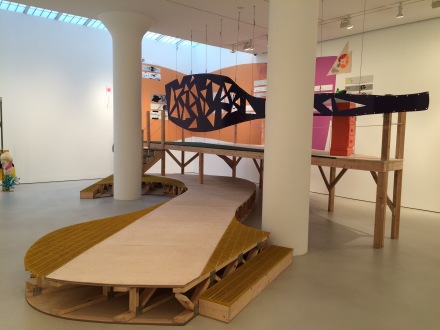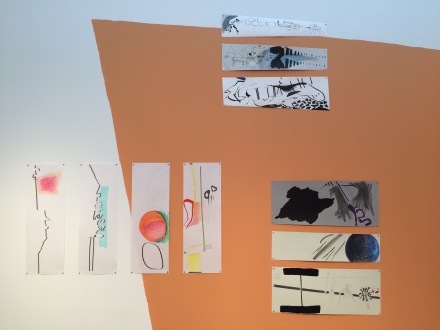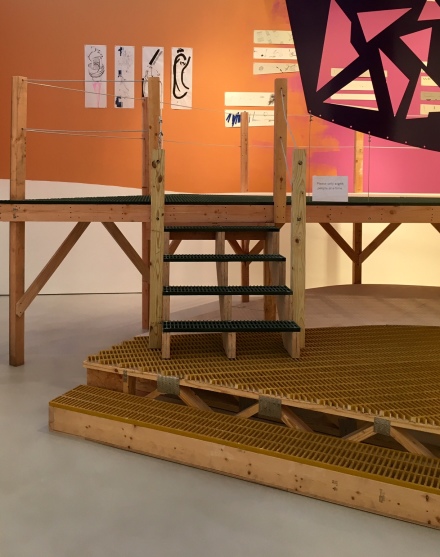
Jessica Stockholder, The Guests All Crowded Into the Dining Room (Installation View), via Art Observed
In The Guests All Crowded Into the Dining Room, Jessica Stockholder’s scattered arrangements of sculptural elements play with assumed boundaries to become a fluid meditation on space. Through a variety of materials and forms, Stockholder avoids overtly breaking down traditional artistic lines, so much as she highlights that they have never truly existed at all. Here, in her third show at Mitchell-Innes & Nash, Stockholder adds new dimension to her longstanding interest in intersection and continues to define the multifaceted significance of surface and structure.
![Jessica Stockholder, Security Detail [JS 688] (2016), via Art Observed](http://artobserved.com/artimages/2016/09/Jessica-Stockholder-Security-Detail-JS-688-2016-via-Art-Observed-440x441.png)
Jessica Stockholder, Security Detail [JS 688] (2016), via Art Observed
Stockholder invokes this effortless integration through a blending of binaries. Her works throughout the show blur the lines between created and found, ownership and obscurity, sculpture and painting. This is particularly evident in the nature of her “Assists” series, in which the artist uses chairs in combination with other found materials to imitate the frame inherent to a painting, using the combined elements in a symbiotic relationship that allows them to remain standing. Like a canvass, as the artwork itself does come with its surroundings. Stockholder’s pieces exude her belief that nothing exists in isolation.

Jessica Stockholder, The Guests All Crowded Into the Dining Room (Installation View), via Art Observed
Even Stockholder’s use of the space at Mitchell-Innes & Nash reflects her pieces’ sustained liminality. Her sculptures are spread across the space, loosely orbiting a wooden platform that recalls a stage. The elevation of this object allows for one to both view and be viewed. The platform allows its audience both to better view Stockholder’s abstract drawings, hung parallel to the stage, as well as to gain a new perspective on the artwork and audience below. The platform’s invitation to participate, calling for “no more than 8 people” at a time suggests that not only is sculpture impossible without the effect of painting, but both cannot exist without the interaction of the viewer.

Jessica Stockholder, The Guests All Crowded Into the Dining Room (Installation View), via Art Observed
Through this interest in the interplay between various types of art forms, Stockholder plays with the conventions and preconditions of the art object. In many ways, her interest in the significance of structure speaks to the Deconstructionist impulse to break down traditional surfaces in order to create something new. Similarly, many of her materials–seashells, vibrant plastics– play with constructions of kitsch through Stockholder’s use of found, bought, or gifted materials.
![Jessica Stockholder, Detached Detail [JS 685] (2016), via Art Observed](http://artobserved.com/artimages/2016/09/Jessica-Stockholder-Detached-Detail-JS-685-2016-via-Art-Observed-440x440.jpg)
Jessica Stockholder, Detached Detail [JS 685] (2016), via Art Observed
Despite the way in which The Guests All Crowded Into the Dining Room transforms the perception of a space, Stockholder is hesitant to call her work installation art. In the past, she has instead described her work as creating a “situation,” which resonates strongly with the viewer’s experience of the exhibition. The structural intersections created in Stockholder’s exhibition create a community of artwork, in which boundaries become so fluid so as to cease to exist.
The work will be on view through October 1, 2016.
![Jessica Stockholder, Assist: Smoke and Mirrors [JS 692] (2016), via Art Observed](http://artobserved.com/artimages/2016/09/Jessica-Stockholder-Assist-Smoke-and-Mirrors-JS-692-2016-via-Art-Observed-440x440.jpg)
Jessica Stockholder, Assist: Smoke and Mirrors [JS 692] (2016), via Art Observed
— M. Donovan
Read More:
Jessica Stockholder, The Guests All Crowded Into the Dining Room, Mitchell-Inness & Nash [Exhibition Site]
NYAQ Review [NYAQ]
Time Out New York Interview [Time Out]



